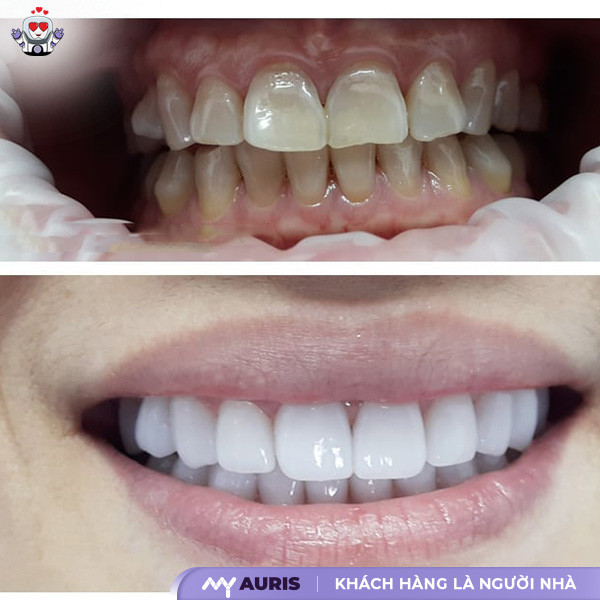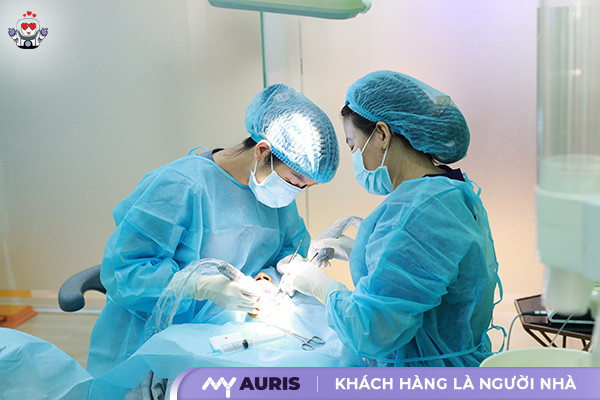After getting dental crowns, many people wonder how long it takes to eat normally again. This is a very practical question as it directly impacts daily life. The recovery time for chewing function will vary depending on individual constitution and the dentist’s technique. This article, with professional consultation from My Auris Dental Clinic, will guide you on how to recognize when it’s safe to eat after getting crowns and important considerations to help your teeth stabilize quickly and reduce potential risks.
How Long Does Dental Crown Placement Take?
On average, dental crown placement takes about 2 to 5 days, depending on the number of teeth to be crowned, oral health condition, and the technology available at the clinic. For cases involving 1–3 teeth, the duration can be shortened to just 2–3 days. If full arch dental crowns or a complete restoration is performed, the process might extend from 5–7 days.
Additionally, some dental clinics using modern CAD/CAM technology can design and place dental crowns in a single day. However, this technique is not applicable in all cases, especially for individuals with weak teeth, those requiring root canal treatment, or meticulous bite adjustment.
The duration of dental crown placement also depends on:
- Current tooth condition: If root canal treatment, gum inflammation, or bite adjustment is required beforehand, it will add a few extra days.
- Dentist’s skill and laboratory workflow: The speed at which the lab fabricates the crowns directly impacts the timeline.
- Number of crowns: More teeth requiring crowns will naturally take longer to complete.

How Long Until You Can Eat Normally After Getting Dental Crowns?
How long after getting dental crowns can you eat normally again? Most patients can resume normal eating after 24 hours, especially if zirconia crowns are used – a type with high strength and good biocompatibility. In reality, the time it takes to resume chewing depends on each stage of the dental restoration process and the degree of compatibility between the crowns and each individual’s body.
Initial Stage: After Temporary Crown Placement
Immediately after tooth preparation (shaping), patients will have temporary crowns placed to protect the prepared teeth and maintain aesthetics while waiting for the permanent crowns to be fabricated. These temporary crowns are typically made from lightweight plastic material and can easily dislodge. Therefore, patients should avoid hard, hot, cold, or sticky foods. This period usually lasts 2 to 3 days. This is a sensitive time, so it’s advisable to only consume soft foods such as porridge, soup, mashed rice, or boiled vegetables to prevent prolonged pain or dislodgement of the temporary crowns.
Next Stage: After Permanent Crown Placement
After the permanent dental crowns are bonded, you should wait approximately 2 – 24 hours for the adhesive to stabilize and bond securely. During this time, avoid chewing on the newly crowned teeth, especially hard or sticky foods. After 24 hours, most patients can resume normal eating, particularly if zirconia crowns are used – a type with high strength and good biocompatibility.
However, if you still feel an uneven bite, pain, or discomfort while eating, you should return to your restorative dentist to have your bite checked or the accuracy of the dental crowns re-evaluated. Some people might experience sensitivity after the procedure, but it usually subsides after a few days if there are no other complications.
Difficulty Eating After Dental Crowns – Causes and Solutions
After getting dental crowns, experiencing difficulty eating is not uncommon, but it’s important to understand the causes to find appropriate solutions.
Causes of Difficulty Eating After Dental Crowns
Inaccurate Bite Alignment
If the bite is misaligned after dental crown placement, patients may feel an uneven sensation or obstruction, causing difficulty in chewing. This is the most common reason for experiencing discomfort while eating. Checking the bite after crown placement is a crucial step in the dental restoration process. If overlooked, patients will feel discomfort every time they chew.
Errors in Impression Taking and Crown Fabrication
During the impression-taking process, if the dentist or laboratory makes an error, the fabricated crown may not fit snugly over the prepared tooth. This reduces chewing efficiency, causes sensitivity, and diminishes the enjoyment of eating.
Overly Thick or Hard Crowns
Some types of zirconia or metal-ceramic crowns have high hardness, and if not adjusted to the correct thickness, they can feel heavy and cause an uneven sensation when eating. This is particularly common if a personalized treatment plan is not applied according to each individual’s condition.
Issues with Opposing Teeth
If only one side of the mouth has crowns, and the opposing teeth are misaligned, weak, or missing, uneven chewing can also lead to a feeling of discomfort while eating.
Anxiety or Lack of Adaptation
After getting dental crowns, the novel sensation can make many people hesitant to eat. The fear of damaging the crowns, pain, or simply not being accustomed to the new crowns can also cause you to feel unnatural while eating.

Solutions for Difficulty Eating
Re-check Bite Alignment at the Dental Clinic
As soon as you notice uneven chewing or an uneven sensation, you should return to the clinic. The restorative dentist will re-evaluate your bite and make adjustments if necessary. This usually takes only a few minutes and is painless.
Adjust or Replace Crowns if Necessary
If the fabricated crown is not accurate or has an open margin, you should request a re-evaluation. In some cases, replacing the dental crown is necessary to ensure proper chewing function and aesthetics. This is often covered under the warranty policy for dental crowns at reputable dental clinics.
Choose a More Suitable Crown Material
If you are using crowns that are too hard or heavy, you might consider switching to lighter and more aesthetic dental materials, such as Emax porcelain. Customizing the color and shape of the teeth according to each individual will make the teeth look more natural, blend in better, and improve chewing comfort.
Gradual Chewing Practice
Instead of immediately eating hard foods, start with soft foods like porridge, soup, and cooked vegetables. After a few days, you will feel your teeth adapting better. From there, your eating ability and recovery will quickly return to normal.
Maintain Thorough Oral Hygiene
Clean your dental crowns like natural teeth: brush twice a day, use dental floss, alcohol-free mouthwash, and schedule regular check-ups according to your restoration plan. When the oral environment is healthy, the sensation of comfortable eating will gradually return.

What is the Dental Crown Placement Process Like?
Dental crown placement is a common, uncomplicated dental aesthetics procedure that usually takes only 2-5 days, quickly improving chewing function and aesthetics. This procedure does not require surgery, is mostly performed on an outpatient basis, and involves clear steps.
Examination and Dental X-rays
This is the first and foundational step. The dentist will conduct a general examination, take X-rays or CT scans to comprehensively assess the condition of your teeth and jaw, identifying any issues requiring treatment (root canal, gum inflammation, bite) before tooth preparation. You will be advised on your aesthetic desires and the types of dental crowns (zirconia, Emax, metal-ceramic) to choose the most suitable option.
Tooth Preparation and Impression Taking
After the plan is set, the dentist proceeds to prepare the teeth by shaping them into abutments (small posts) for the crowns to fit over. This takes 30 minutes – 1 hour per tooth. This procedure requires high precision to avoid pulp damage. Next, impressions are taken using material or a digital scanner to send to the lab for fabricating crowns that match the natural teeth in size and color. You might experience mild initial sensitivity, but it will gradually subside.
Temporary Crown Placement and Lab Fabrication
Immediately after impressions are taken, temporary crowns made of plastic/composite will be placed to maintain aesthetics, protect the prepared teeth, and reduce sensitivity. You should limit eating hard/hot/cold foods for 2-4 days while waiting for the lab to complete the permanent crowns. The lab uses CAD/CAM technology to fabricate precise dental crowns, taking 24-72 hours (which can be faster for zirconia crowns).
Permanent Crown Bonding and Bite Check
Once the dental crowns are ready, the dentist will try them in temporarily to check their color, shape, fit, and bite. If satisfactory, the crowns will be permanently bonded using specialized dental adhesive. The dentist will re-check the bite with articulating paper and make adjustments to ensure there is no discomfort or jaw misalignment when eating. This process takes about 30-45 minutes per tooth. Afterward, you need to rest for 24 hours for stabilization.

Tips to Shorten Dental Crown Placement Time and Speed Up Recovery
To shorten the dental crown placement time and expedite recovery, patients should keep the following specific steps in mind:
- Choose a Dental Clinic with CAD/CAM Technology
One factor that helps speed up dental crown placement is a clinic that uses digital impression scanners and CAD/CAM technology. Instead of manual impressions, the dentist will use a 3D scanner to accurately create a digital model of the crown. This process saves time, avoids inaccuracies, and can shorten the procedure to just 1–2 appointments. This is an ideal choice in modern dental service packages.
- Appropriate Treatment Indication for Your Tooth Condition
Not all cases require extensive tooth preparation or root canal treatment. Individuals with strong, healthy teeth, free from decay or gum inflammation, will not need intermediate steps such as root canal treatment, fillings, or complex bite adjustments. As a result, the dental crown placement time can be significantly reduced. Ensure that your restorative dentist provides clear advice, accurately assesses your condition, and has a specific restoration plan for you.
- Limit Hard Foods in the First 48 Hours
Immediately after permanent crown bonding, avoid hard, chewy, hot, or cold foods to prevent pressure on the newly placed crowns. Following this guideline will help the area around the teeth recover quickly and reduce post-procedure sensitivity. It is advisable to eat soft, easily swallowed foods and drink plenty of water to maintain oral moisture.
- Follow-up Appointments on Schedule, Without Delay
After the crowning procedure is complete, the dentist usually schedules follow-up appointments to check the bite, the stability of the crowns, and the patient’s chewing sensation. Delaying follow-up appointments can lead to minor discrepancies becoming more severe, prolonging the adjustment and recovery time. Adhering to your appointments will help you complete the procedure faster and more safely.
- Prioritize Suitable and Durable Crown Materials
Choosing quality dental crown materials like zirconia crowns will shorten recovery time due to their high biocompatibility and low irritation. Good quality crowns also reduce breakage, thus avoiding the need for replacement, saving both time and cost in the future. Do not opt for cheap, easily damaged crowns, as they may require multiple re-treatments, affecting your initial dental crown schedule.
The information shared above not only helps you understand that teeth should be crowned as soon as possible after root canal treatment but also provides guidance on proper dental crown care to ensure better protection for your natural teeth. Dental crowning is a safe and quick restoration method that effectively enhances smile aesthetics. Therefore, you can confidently choose this option to maintain long-term oral health.





